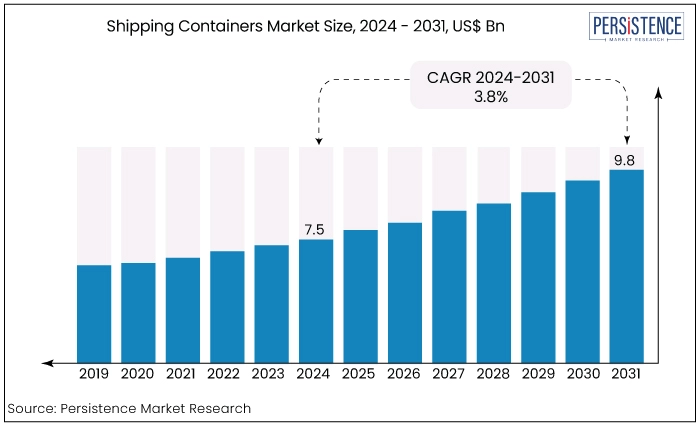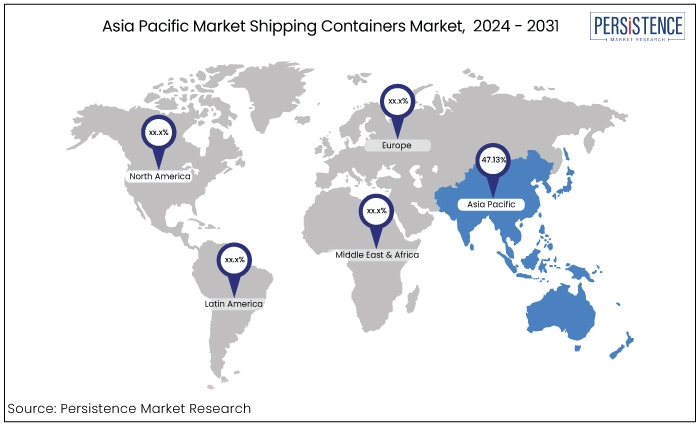Industry: Automotive & Transportation
Published Date: September-2024
Format: PPT*, PDF, EXCEL
Delivery Timelines: Contact Sales
Number of Pages: 177
Report ID: PMRREP6748
The shipping containers market is estimated to value at US$9.8 Bn in 2031, from the value US$7.5 Bn recorded in 2024. The market is projected to expand at a CAGR of 3.8% during the forecast period. Investments in port and logistics infrastructure are facilitating more efficient container handling and transportation. This infrastructure development supports the growth of the shipping container market by increasing the capacity to manage larger volumes of containers

Key Highlights of the Market
|
Attributes |
Key Insights |
|
Market Size (2024E) |
US$7.5 Bn |
|
Projected Market Value (2031F) |
US$9.8 Bn |
|
Global Market Growth Rate (CAGR 2024 to 2031) |
3.8% |
|
Historical Market Growth Rate (CAGR 2019 to 2023) |
3.3% |
|
Region |
Market Share in 2024 |
|
Asia Pacific |
47.13% |
Asia Pacific shipping containers market leads the sector and is projected to hold a 47.13% market share in 2024 fueled by increasing trade activities. China, as a manufacturing giant manages the highest volumes of containerized cargo followed by countries like Korea, Japan, India, and ASEAN nations adopting sea-faring containers for goods transport.
Affordable labor and resources in Asia attract global manufacturers to establish local production facilities boosting intra-Asia and export trade. Investments in new container terminals and mega ports in China and India further enhance infrastructure supporting regional market growth in shipping containers.
|
Region |
CAGR in 2024 |
|
North America |
6.15% |
North America market is the rapidly growing industry and is projected to expand at a CAGR of 6.15% in 2024. The region's prominent container transportation companies and busy seaports contribute significantly to global container trade.
The U.S. leads the market due to robust trade relationships with leading ports like Los Angeles, Long Beach, New York, and New Jersey globally. Additionally, North America's well-established intermodal infrastructure facilitates efficient container transfers between ships, trucks, and railways, while stable macroeconomic conditions and high consumer demand support healthy container traffic volumes.

|
Category |
Market Shares by 2024 |
|
Container Size - Large Containers |
53.8% |
Large containers (40 feet) are projected to capture the high market share of 53.8% in 2024 due to their economies of scale. These containers enable shippers to transport 50% more cargo than smaller 20-foot containers significantly lowering transportation costs per unit.
Versatility of the containers allows for various cargo configurations, while the standardized design facilitates seamless intermodal transfers between ships, trucks, and trains. This ease of multimodal transportation enhances the appeal of large containers among shippers, driving their preference in the logistics industry.
|
Category |
Market Shares by 2024 |
|
Container Type- Dry Storage Containers |
64.9% |
Dry storage containers are projected to dominate the market with 64.9% share in 2024 driven by significant volumes of general cargo transported via sea. These containers efficiently carry a range of bulk commodities and packaged goods including garments, consumer products, machinery, and millwork without refrigeration needs. Their flexibility and low shipping costs make them the preferred choice for non-perishable cargo transport. Additionally, the universal applicability for most non-hazardous dry goods has led to an increasing demand for dry storage containers in the shipping industry.
The shipping containers market refers to the industry encompassing the design, manufacturing, leasing, and sale of standardized containers used for transporting goods across various modes of transport. These transport modes are ships, trucks, and trains.
Shipping containers are also known as intermodal containers and are typically made from steel and are designed to be durable and weather-resistant, allowing them to protect cargo over long distances and various environmental conditions. These containers work by providing a modular and universally accepted method of transport facilitating the efficient and secure movement of goods across global supply chains.
The industry is currently experiencing transformative trends driven by technological advancements, sustainability initiatives, and evolving consumer demands. One notable trend is the increasing integration of digital technologies such as the Internet of Things (IoT) and blockchain to enhance tracking and monitoring capabilities throughout the supply chain.
Technologies enable real-time visibility of cargo, improving operational efficiency and reducing theft or loss incidents. There is a growing focus on eco-friendly practices prompting manufacturers to explore sustainable materials and designs that minimize environmental impact.
The rise of e-commerce has also contributed to heightened demand for shipping containers as businesses seek to optimize logistics and meet consumer expectations for rapid delivery. The trend of converting shipping containers into adaptable spaces, such as homes and pop-up shops, is gaining momentum, showcasing their potential beyond traditional uses.
Market trends are expected to shape the future landscape of the shipping containers industry driving innovation and redefining operational strategies.
The shipping containers market has indicated steady growth over the past few years. From 2019 to 2023. The market experienced a CAGR of 3.3% driven by the increasing globalization of trade, expanding e-commerce sector, and the need for efficient logistics solutions. This growth period was characterized by robust demand for shipping containers as businesses sought to enhance their supply chain capabilities.
Factors such as infrastructure investments in ports and transportation systems also contributed to this positive trajectory allowing for efficient container movement and handling.
The market is projected to maintain upward growth with an anticipated CAGR of 3.8% from 2024 to 2031. The ongoing digital transformation in logistics will enhance operational efficiencies, leading to great adoption of shipping containers across various sectors. Additionally, the continued rise in global trade particularly in developing economies will drive demand for containerized transport solutions.
Sustainability initiatives will also play a crucial role as stakeholders increasingly prioritize eco-friendly practices potentially leading to the adoption of innovative container designs and materials.
The diversification of container uses including temporary housing and retail spaces is likely to open new market opportunities. The market is set to evolve dynamically balancing traditional freight needs with modern trends and challenges ahead.
Continuous Expansion of Global Trade
The continuous expansion of global trade is a significant driver for the market growth. As economies become increasingly interconnected, the demand for efficient transportation solutions rises.
Countries are engaging in more trade agreements leading to higher volumes of goods being transported internationally. This trend is particularly evident in emerging markets, where industrialization and urbanization are fueling the need for containerized shipping. The standardization of shipping containers facilitates smoother logistics and reduces costs, making them the preferred choice for transporting goods across borders.
Rapid Growth of E-commerce Boom
The rapid growth of e-commerce has transformed market driving demand for efficient logistics and distribution networks. As consumers increasingly expect fast and reliable delivery of goods, businesses are investing in containerized shipping solutions to meet these demands.
The rise of online shopping has led to a surge in small parcel shipments, which often utilize shipping containers for bulk transport to distribution centers. This trend not only enhances supply chain efficiency but also encourages innovation in container design and usage further propelling market growth.
Technological Innovations
Technological innovations are reshaping the shipping containers market demand by enhancing operational efficiency and safety. The integration of digital technologies such as IoT and blockchain, allows for real-time tracking and monitoring of containers improving visibility throughout the supply chain.
Advancements help reduce losses and optimize logistics processes making container shipping attractive to businesses. Additionally, innovations in container design such as modular and eco-friendly options, are expanding the applications of shipping containers beyond traditional freight driving further growth in the market.
Persistent Shortage of Containers
One of the significant challenges impeding the shipping containers market sales is the persistent shortage of containers. This issue has been exacerbated by disruptions caused by COVID-19 pandemic, which led to imbalances in supply and demand.
As global trade rebounded, the demand for containers surged, but production and repositioning lagged behind. This shortage not only drives up shipping costs but also creates delays in the supply chain, affecting businesses that rely on timely deliveries. The inability to secure sufficient containers can hinder operational efficiency and limit market growth.
Port Congestion
Port congestion is another critical factor impeding the market. Increased shipping volumes coupled with labor shortages and logistical inefficiencies have led to significant delays at major ports globally. This congestion results in long turnaround times for vessels, increased shipping costs, and a ripple effect throughout the supply chain.
As containers remain stuck at ports, businesses face challenges in inventory management and fulfillment, which can lead to lost sales and dissatisfied customers. Addressing port congestion is essential for improving the overall efficiency of the market.
Sustainable Container Solutions
As environmental concerns gain prominence, there is a significant opportunity for the shipping containers market expansion and innovation in sustainable container solutions. Manufacturers can focus on developing eco-friendly containers made from recycled materials or utilizing alternative energy sources for production.
The trend toward reducing carbon footprints in logistics presents opportunities for creating containers designed to optimize fuel efficiency during transportation. By addressing sustainability, companies can attract environmentally conscious clients and comply with increasingly stringent regulations.
Modular Container Applications
The versatility of intermodal containers presents several promising opportunity for expanding their use in modular applications. Beyond traditional freight transport, shipping containers can be adapted for various purposes such as temporary housing, mobile retail spaces, or even disaster relief shelters.
As urbanization continues to rise and the demand for affordable housing increases, modular container solutions can offer innovative alternatives. Additionally, businesses seeking flexible, cost-effective workspace solutions may turn to converted containers. This trend not only enhances the market's growth potential but also showcases the adaptability of shipping containers in diverse sectors.
The shipping containers market is witnessing swift growth reflecting its dynamic nature. Industry players are launching new products and integrating innovative technologies to create new opportunities in the sector.
Companies are adopting key business strategies to broaden their product ranges, increase market shares in various regions, and enhance supply chains for great market value.
Recent Developments in the Shipping Containers Market
|
Attributes |
Details |
|
Forecast Period |
2024 to 2031 |
|
Historical Data Available for |
2019 to 2023 |
|
Market Analysis |
US$ Billion for Value |
|
Key Regions Covered |
|
|
Key Market Segments Covered |
|
|
Key Companies Profiled |
|
|
Report Coverage |
|
|
Customization & Pricing |
Available upon request |
By Container Size
By Container Type
By Region
To know more about delivery timeline for this report Contact Sales

The market is predicted to rise from US$7.5 Bn in 2024 to US$9.8 Bn by 2031.
A few of the leading manufactures are Almar Container Group, CARU Containers BV, and China International Marine Containers Co. Ltd.
Dry storage containers are leading and to dominate the industry with a 64.9% share in 2024.
Asia Pacific region is leading in the market and is expected to reach 47.13% market share in 2024.
Conversion of shipping containers into adaptable spaces is a key trend in the market.